Found a total of 10000 related content

Show Thumbnail of Image Upload AJAX/PHP
Article Introduction:Update 18/11/2012: The new version of this upload is now here JQUERY AJAX IMAGE UPLOAD THUMBNAIL EXAMPLE.
This is how you can add a file/image upload tool to your forms and have AJAX store the file with PHP and return a thumbnailed version to the us
2025-03-04
comment 0
1110

jQuery AJAX Image Upload Thumbnail Example
Article Introduction:This article demonstrates how to upload images using Ajax and display a thumbnail preview without page reloads. The process involves client-side JavaScript for handling the upload and a PHP backend for thumbnail generation and image storage.
Client
2025-02-24
comment 0
493

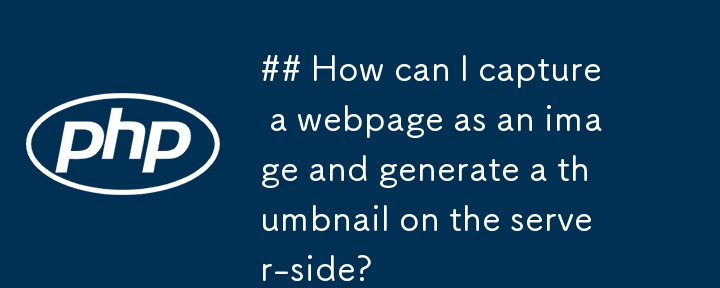
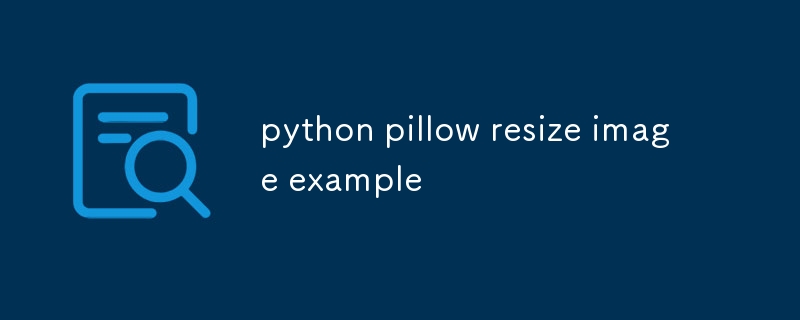
python pillow resize image example
Article Introduction:Use Pillow to adjust the image size to select methods based on whether the aspect ratio is maintained: 1. Direct resize() will stretch the image, which is suitable for scenes where proportions are not required; 2. Use thumbnail() to automatically maintain the aspect ratio, generate undistorted thumbnails, and the maximum size does not exceed the specified value; 3. Custom resize_with_aspect_ratio() function can flexibly control the target width and height, and improve quality by calculating the scaling ratio and using LANCZOS resampling; 4. Pay attention to the image mode during processing, and convert it to RGB if necessary to avoid saving errors; 5. It is recommended to use thumbnail() or custom functions to maintain the image proportions, avoid deformation, and finally save or display the results.
2025-07-26
comment 0
175

How to use PHP to combine AI to generate image. PHP automatically generates art works
Article Introduction:PHP does not directly perform AI image processing, but integrates through APIs, because it is good at web development rather than computing-intensive tasks. API integration can achieve professional division of labor, reduce costs, and improve efficiency; 2. Integrating key technologies include using Guzzle or cURL to send HTTP requests, JSON data encoding and decoding, API key security authentication, asynchronous queue processing time-consuming tasks, robust error handling and retry mechanism, image storage and display; 3. Common challenges include API cost out of control, uncontrollable generation results, poor user experience, security risks and difficult data management. The response strategies are setting user quotas and caches, providing propt guidance and multi-picture selection, asynchronous notifications and progress prompts, key environment variable storage and content audit, and cloud storage.
2025-07-25
comment 0
1018

What is the autoload section in composer.json?
Article Introduction:Composer.json's autoload configuration is used to automatically load PHP classes, avoiding manual inclusion of files. Use the PSR-4 standard to map the namespace to a directory, such as "App\":"src/" means that the class under the App namespace is located in the src/ directory; classmap is used to scan specific directories to generate class maps, suitable for legacy code without namespace; files are used to load a specified file each time, suitable for function or constant definition files; after modifying the configuration, you need to run composerdump-autoload to generate an automatic loader, which can be used in the production environment --optimize or --classmap-
2025-06-12
comment 0
604

How do I create a new model in Yii?
Article Introduction:There are two main ways to create models in the Yii framework: 1. Use Gii to automatically generate models, and you can generate model classes and CRUD code by enabling Gii tools and accessing its interface to enter table names and class names; 2. Create a model file manually, create a new PHP file in models/ directory and define a class inherited from yii\db\ActiveRecord, and implement tableName(), rules(), attributeLabels() and other methods; in addition, you need to pay attention to the model naming specifications, automatic filling fields, model locations, and the difference between AR and non-AR models, and choose the appropriate method according to actual needs.
2025-07-14
comment 0
352

How do I configure classmap autoloading in my composer.json file?
Article Introduction:To configure the automatic loading of Composer's classmap, first use the "classmap" key under "autoload" in composer.json to specify the directory or file. For example: {"autoload":{"classmap":["lib/","database/models/"]}}, Composer will scan the .php file in these paths and generate class maps. You can also specify a single file such as legacy_class.php. renew
2025-07-14
comment 0
746
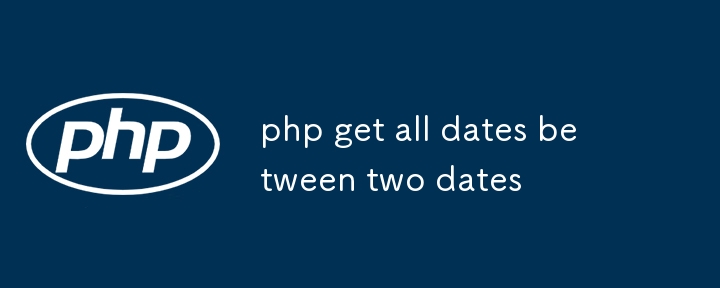
php get all dates between two dates
Article Introduction:To get all dates between two dates, it is not difficult to implement with PHP. Just pay attention to the time format and loop logic, and it can be easily done. Generate date list using the DateTime class PHP's built-in DateTime class is a good tool for handling dates. We can use it to iterate through every day between the start date and the end date. functiongetDatesBetween($start,$end){$dates=[];$current=newDateTime($start);$end=newDateTime($end);whi
2025-07-06
comment 0
387

Imagick vs GD
Article Introduction:Key Points
GD and ImageMagick are both popular PHP image processing libraries. GD is more widely used and ImageMagick is more powerful.
In terms of performance, there is no absolute advantage or disadvantage between the two, and the speed depends on the specific application scenario.
The encoding styles are significant. GD adopts procedural programming, and ImageMagick supports object-oriented programming through the Imagick class.
In addition to these two libraries, there are other options, such as cloud image processing platforms or components that have been integrated into the application.
introduction
In PHP applications, if you need to create thumbnails, apply image filters, or perform other image conversions, you need to use the image processing library. Usually, you'll choose GD or ImageMagick. But which library
2025-02-22
comment 0
1301

How to write unit tests for WordPress code
Article Introduction:Writing WordPress unit tests requires using PHPUnit and WordPress test suites. 1. Set up the environment: Install PHP and Composer, install PHPUnit through Composer, clone the wordpress-develop repository, configure a dedicated database, and use wpscaffold to generate test files. 2. Understand the test structure: inherit the WP_UnitTestCase class, the test method starts with test_, and use the factory class to create test data to avoid real HTTP requests. 3. Write effective tests: cover normal and boundary situations, verify function behavior, hook triggers, and shortcode output, keep the test independent and focused. 4. Run and debug:
2025-07-25
comment 0
237

PHP Master | Adding Text Watermarks with Imagick
Article Introduction:Imagick PHP extension library details: Add text watermark to images
This article will explain how to use PHP's Imagick extension library to add text watermarks to images. We will explore a variety of methods, including simple text overlay, creating transparent text watermarks using font masks, and more advanced text tiling techniques.
Key points:
Imagick is a powerful PHP extension library that can be used to process images, including adding text watermarks.
Text watermarking can be achieved by creating an Imagick class instance, reading an image, setting the font properties using the ImagickDraw instance, and then adding text to the image using the annotateImage() method.
There are many ways to add text
2025-02-25
comment 0
343

How can you handle file uploads securely in PHP?
Article Introduction:To safely handle file uploads in PHP, the core is to verify file types, rename files, and restrict permissions. 1. Use finfo_file() to check the real MIME type, and only specific types such as image/jpeg are allowed; 2. Use uniqid() to generate random file names and store them in non-Web root directory; 3. Limit file size through php.ini and HTML forms, and set directory permissions to 0755; 4. Use ClamAV to scan malware to enhance security. These steps effectively prevent security vulnerabilities and ensure that the file upload process is safe and reliable.
2025-06-19
comment 0
1164
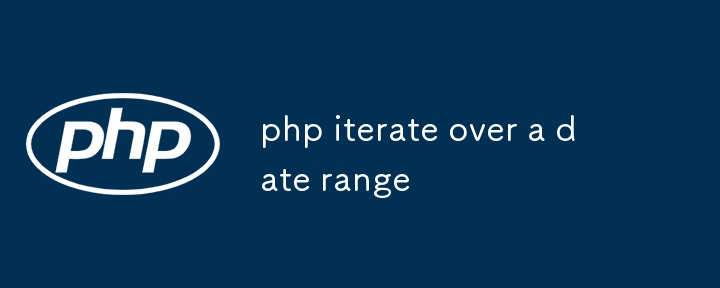
php iterate over a date range
Article Introduction:It is recommended to use the DatePeriod class to traverse date ranges in PHP. 1. The DatePeriod class was introduced from PHP5.3, and date traversal is implemented by setting the start date, end date and interval. For example, generate a date list from 2024-01-01 to 2024-01-05, which does not include the end date by default; 2. If you need to include the end date, you can adjust the end date or set the INCLUDE_END_DATE parameter; 3. The manual loop method can also complete the traversal using the DateTime object and the modify() method, which is suitable for scenarios where step size needs to be flexibly controlled; 4. Pay attention to the time zone problem that should be explicitly set to avoid the system's default time zone affecting the result; 5. PHP automatically handles leap years
2025-07-14
comment 0
166
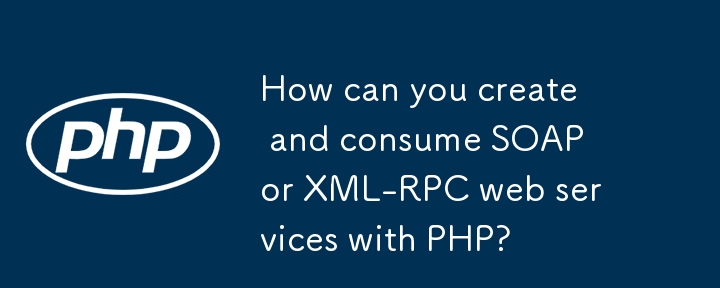
How can you create and consume SOAP or XML-RPC web services with PHP?
Article Introduction:How to create and consume SOAP or XML-RPC network services using PHP? 1. For SOAP services, use the SoapServer class to define processing logic on the server side and generate WSDL files, bind classes or functions to respond to requests; use the SoapClient class to call remote methods on the client side and ensure that the php_soap extension is enabled. 2. For XML-RPC services, you need to use XML_RPC3 and other libraries to register methods on the server side and process requests, and send XML-RPC messages to the client for calls. 3. Common precautions include: enabling necessary extensions, disabling WSDL cache for development, correctly handling errors and exceptions, using debugging tools to view request content, ensuring security and checking
2025-06-07
comment 0
941

How do I configure files autoloading in my composer.json file?
Article Introduction:To use Composer to set up automatic loading of PHP projects, you must first edit the composer.json file and select the appropriate automatic loading method. If the most commonly used PSR-4 standard is adopted, the mapping of namespace and directory can be defined in the psr-4 field of autoload, such as mapping MyApp\ to src/directory, so that the MyApp\Controllers\HomeController class will automatically load from src/Controllers/HomeController.php; 1. After the configuration is completed, run composerdumpautoload to generate an automatic loading file; 2. If you need to be compatible with old code, you can use it.
2025-06-19
comment 0
740

How do I install the dependencies listed in my composer.json file? (composer install)
Article Introduction:The most direct way to install dependencies is to run composerinstall. The specific steps are as follows: 1. Make sure that Composer is installed, and you can check the version through composer--version; 2. Enter the project root directory and execute composerinstall. This command will install dependencies based on composer.json and composer.lock, generate automatic loading configurations and store them in vendor/directory; 3. You can use --no-dev to skip development dependencies, -o optimization class loader, --prefer-dist priority download of zip files, etc. to enhance control; 4. If the installation fails, common reasons include incompatible PHP versions and lack of extensions
2025-07-16
comment 0
572

How do I use asset bundles in Yii?
Article Introduction:Using Yii's assetbundles is a best practice for managing CSS and JS files. It defines resource groups centrally through PHP classes, and automatically handles dependencies, merging and caches. 1. The resource package is a PHP class used to organize CSS, JS and other resources and declare their dependencies; 2. Register resource packages in the view or layout to automatically generate HTML tags; 3. Different resource packages can be conditionally registered according to user role or page type; 4. The resource files are placed in web/css and web/js by default, and the path can be customized; 5. Use the assetManager configuration to add timestamps to achieve version control, solving browser caching problems. Correct use of resource packages can improve project structure clarity and loading efficiency
2025-07-08
comment 0
764

Explain Laravel Database Migrations.
Article Introduction:Database migration is a version control tool in Laravel for managing database structure changes. It allows the use of PHP code to define and synchronize table structures to avoid manual operation of the database. 1. The migration file contains methods for up() to perform changes and down() rollback changes; 2. Use the Schema builder and Blueprint class to create tables and fields, and support common types and constraints; 3. Common Artisan commands include migrate run, rollback rollback, reset reset, refresh refresh, and make:migration to generate new files; 4. The recommended practice is to not modify the running migration, but create new files for adjustments, and fill data with factories and seeds.
2025-07-22
comment 0
730



















